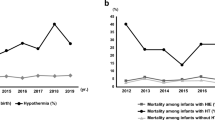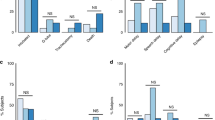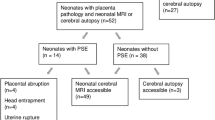Abstract
Objective
To identify antenatal and intrapartum risk factors for neonatal hypoxic ischemic encephalopathy (HIE).
Study design
A single center, retrospective cohort study was conducted for 25,494 singleton births ≥36 weeks’ gestation born between 2009 and 2016. Univariate and multivariate analyses were performed to identify risk factors for HIE.
Results
Thirty-seven infants met HIE inclusion criteria. Independent antenatal risk factors included primigravida, previous fetal death/stillbirth, antidepressant use, illicit drug use, Rh sensitization, and adjusted gestational weight gain >13.6 kg. Independent intrapartum risk factors identified were placental abruption, ruptured uterus, moderate-to-heavy meconium stained amniotic fluid, and delivery by cesarean-section. An intrapartum risk factor was present in 70.3% of the HIE group compared with 29.6% of the non-HIE group.
Conclusion
Intrapartum period risk factors appear to be important for the development of HIE. Gestational weight gain may serve as an important modifiable factor to reduce the risk of HIE.
This is a preview of subscription content, access via your institution
Access options
Subscribe to this journal
Receive 12 print issues and online access
$259.00 per year
only $21.58 per issue
Buy this article
- Purchase on Springer Link
- Instant access to full article PDF
Prices may be subject to local taxes which are calculated during checkout
Similar content being viewed by others
Notes
Genital herpes, genital warts, trichomoniasis, syphilis, chlamydia, gonorrhea, other sexually transmitted infection, infections yeast, infections bacterial vaginosis, hepatitis B, hepatitis C, HIV positive, parvovirus B19, urinary tract infection, other infectious disease, cytomegalovirus, toxoplasmosis, or listeria
Amphetamines, cocaine, barbiturates, opiates (includes heroin use), hallucinogens, rohypnol, or other substances
References
Kurinczuk JJ, White-Koning M, Badawi N. Epidemiology of neonatal encephalopathy and hypoxic-ischaemic encephalopathy. Early Hum Dev. 2010;86:329–38.
Mortality GBD, Causes of Death C. Global, regional, and national age-sex specific all-cause and cause-specific mortality for 240 causes of death, 1990–2013: a systematic analysis for the Global Burden of Disease Study 2013. Lancet. 2015;385:117–71.
Azzopardi DV, Strohm B, Edwards AD, Dyet L, Halliday HL, Juszczak E, et al. Moderate hypothermia to treat perinatal asphyxial encephalopathy. N Engl J Med. 2009;361:1349–58.
Gluckman PD, Wyatt JS, Azzopardi D, Ballard R, Edwards AD, Ferriero DM, et al. Selective head cooling with mild systemic hypothermia after neonatal encephalopathy: multicentre randomised trial. Lancet. 2005;365:663–70.
Jacobs SE, Morley CJ, Inder TE, Stewart MJ, Smith KR, McNamara PJ, et al. Whole-body hypothermia for term and near-term newborns with hypoxic-ischemic encephalopathy: a randomized controlled trial. Arch Pediatr Adolesc Med. 2011;165:692–700.
Shankaran S, Laptook AR, Ehrenkranz RA, Tyson JE, McDonald SA, Donovan EF, et al. Whole-body hypothermia for neonates with hypoxic-ischemic encephalopathy. N Engl J Med. 2005;353:1574–84.
Simbruner G, Mittal RA, Rohlmann F, Muche R. neo.n EnTP. Systemic hypothermia after neonatal encephalopathy: outcomes of neo.nEURO.network RCT. Pediatrics. 2010;126:e771–8.
Zhou WH, Cheng GQ, Shao XM, Liu XZ, Shan RB, Zhuang DY, et al. Selective head cooling with mild systemic hypothermia after neonatal hypoxic-ischemic encephalopathy: a multicenter randomized controlled trial in China. J Pediatr. 2010;157:367–72. 72 e1-3.
Tagin MA, Woolcott CG, Vincer MJ, Whyte RK, Stinson DA. Hypothermia for neonatal hypoxic ischemic encephalopathy: an updated systematic review and meta-analysis. Arch Pediatr Adolesc Med. 2012;166:558–66.
Volpe JJ. Neonatal encephalopathy: an inadequate term for hypoxic-ischemic encephalopathy. Ann Neurol. 2012;72:156–66.
Badawi N, Kurinczuk JJ, Keogh JM, Alessandri LM, O’Sullivan F, Burton PR, et al. Antepartum risk factors for newborn encephalopathy: the Western Australian case-control study. BMJ. 1998;317:1549–53.
Badawi N, Kurinczuk JJ, Keogh JM, Alessandri LM, O’Sullivan F, Burton PR, et al. Intrapartum risk factors for newborn encephalopathy: the Western Australian case–control study. BMJ. 1998;317:1554–8.
Nelson KB, Bingham P, Edwards EM, Horbar JD, Kenny MJ, Inder T, et al. Antecedents of neonatal encephalopathy in the Vermont Oxford Network Encephalopathy Registry. Pediatrics. 2012;130:878–86.
West CR, Curr L, Battin MR, Harding JE, McCowan LM, Belgrave S, et al. Antenatal antecedents of moderate or severe neonatal encephalopathy in term infants-a regional review. Aust N Z J Obstet Gynaecol. 2005;45:207–10.
Locatelli A, Incerti M, Paterlini G, Doria V, Consonni S, Provero C, et al. Antepartum and intrapartum risk factors for neonatal encephalopathy at term. Am J Perinatol. 2010;27:649–54.
Martinez-Biarge M, Diez-Sebastian J, Wusthoff CJ, Mercuri E, Cowan FM. Antepartum and intrapartum factors preceding neonatal hypoxic-ischemic encephalopathy. Pediatrics. 2013;132:e952–9.
Parker SJ, Kuzniewicz M, Niki H, Wu YW. Antenatal and intrapartum risk factors for hypoxic-ischemic encephalopathy in a US birth cohort. J Pediatr. 2018;203:163–9.
Novak CM, Eke AC, Ozen M, Burd I, Graham EM. Risk factors for neonatal hypoxic-ischemic encephalopathy in the absence of sentinel events. Am J Perinatol. 2019;36:27–33.
Hayes BC, McGarvey C, Mulvany S, Kennedy J, Geary MP, Matthews TG, et al. A case–control study of hypoxic-ischemic encephalopathy in newborn infants at >36 weeks gestation. Am J Obstet Gynecol. 2013;209:29 e1–e19.
American College of O, Gynecologists. ACOGCommittee opinion no. 548: weight gain during pregnancy. Obstet Gynecol. 2013;121:210–2.
Fenton TR. A new growth chart for preterm babies: Babson and Benda’s chart updated with recent data and a new format. BMC Pediatr. 2003;3:13.
Kramer MS, Platt RW, Wen SW, Joseph KS, Allen A, Abrahamowicz M, et al. A new and improved population-based Canadian reference for birth weight for gestational age. Pediatrics. 2001;108:E35.
Goldstein RF, Abell SK, Ranasinha S, Misso M, Boyle JA, Black MH, et al. Association of gestational weight gain with maternal and infant outcomes: a systematic review and meta-analysis. JAMA. 2017;317:2207–25.
Siega-Riz AM, Viswanathan M, Moos MK, Deierlein A, Mumford S, Knaack J, et al. A systematic review of outcomes of maternal weight gain according to the Institute of Medicine recommendations: birthweight, fetal growth, and postpartum weight retention. Am J Obstet Gynecol. 2009;201:339 e1–14.
Stotland NE, Cheng YW, Hopkins LM, Caughey AB. Gestational weight gain and adverse neonatal outcome among term infants. Obstet Gynecol. 2006;108:635–43.
Zhou Y, Li H, Zhang Y, Zhang L, Liu J, Liu J. Rate of gestational weight gain and adverse pregnancy outcomes in rural nulliparous women: a prospective cohort analysis from China. Br J Nutr. 2019;122:352–9.
Antony KM, Ma J, Mitchell KB, Racusin DA, Versalovic J, Aagaard K. The preterm placental microbiome varies in association with excess maternal gestational weight gain. Am J Obstet Gynecol. 2015;212:653 e1–16.
American College of O, Gynecology Committee on Practice B-O. ACOG practice bulletin number 49, December 2003: dystocia and augmentation of labor. Obstet Gynecol. 2003;102:1445–54.
Kilpatrick SJ, Laros RK Jr. Characteristics of normal labor. Obstet Gynecol. 1989;74:85–7.
Laughon SK, Berghella V, Reddy UM, Sundaram R, Lu Z, Hoffman MK. Neonatal and maternal outcomes with prolonged second stage of labor. Obstet Gynecol. 2014;124:57–67.
Savitz DA, Stein CR, Siega-Riz AM, Herring AH. Gestational weight gain and birth outcome in relation to prepregnancy body mass index and ethnicity. Ann Epidemiol. 2011;21:78–85.
Acknowledgements
We thank Kathy Gollmar, RN and Carla Griffin, RN for PeriData.Net® data coordination and support at UnityPoint Health-Meriter. We also express thanks to The Wisconsin Association for Perinatal Care and The Center for Perinatal Care, UnityPoint Health-Meriter, Madison, WI for their role in supporting this research.
Author information
Authors and Affiliations
Corresponding author
Ethics declarations
Conflict of interest
The authors declare that they have no conflict of interest.
Additional information
Publisher’s note Springer Nature remains neutral with regard to jurisdictional claims in published maps and institutional affiliations.
Rights and permissions
About this article
Cite this article
Peebles, P.J., Duello, T.M., Eickhoff, J.C. et al. Antenatal and intrapartum risk factors for neonatal hypoxic ischemic encephalopathy. J Perinatol 40, 63–69 (2020). https://doi.org/10.1038/s41372-019-0531-6
Received:
Revised:
Accepted:
Published:
Issue Date:
DOI: https://doi.org/10.1038/s41372-019-0531-6
This article is cited by
-
Correlation analysis between the amniotic fluid contamination and clinical grading of neonatal hypoxic–ischemic encephalopathy and biomarkers of brain damage
BMC Pediatrics (2024)
-
Outcomes of infants with hypoxic-ischemic encephalopathy during COVID-19 pandemic lockdown in Canada: a cohort study
Child's Nervous System (2022)
-
Emerging therapies and management for neonatal encephalopathy—controversies and current approaches
Journal of Perinatology (2021)
-
Blood biomarkers for neonatal hypoxic–ischemic encephalopathy in the presence and absence of sentinel events
Journal of Perinatology (2021)
-
Epigenetics modifiers: potential hub for understanding and treating neurodevelopmental disorders from hypoxic injury
Journal of Neurodevelopmental Disorders (2020)



